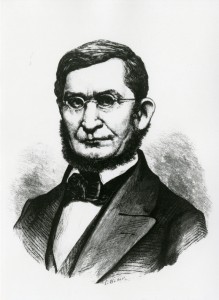By Sarah Alger
Accounts by patients of surgery before anesthesia are harrowing, to say the least. Reading one description by a man who underwent an amputation in 1843—a scant three years before the first successful public demonstration of anesthesia—I wondered how bitter it must have tasted for him and others who, after millennia with no anesthesia, missed it by a hair’s breadth in time, left to remember the horror for the rest of their lives.
It’s only with the benefit of hindsight that we can ask: The clues were copious—why weren’t they seized upon sooner?
In the 1840s, a Hartford dentist named Horace Wells experimented with nitrous oxide, having seen the gas used as a party drug in public halls and observed that pain was dulled under its influence. In 1845, he led a public demonstration on a dental patient, which failed for reasons unclear, as I described here.
Though Wells was discouraged, his young apprentice, William T.G. Morton, was undeterred. He chose to work with another drug popular at “frolics” of the time period: ether. Morton made the acquaintance of a Harvard chemistry professor named Charles T. Jackson, who suggested that he use a high grade of sulfuric ether. Jackson, who was also trained as a physician, appeared to know that ether could prove useful in surgery, but seems not to have acted on this knowledge.
On October 16, 1846, at Massachusetts General Hospital, Morton successfully administered ether to a surgical patient in a public demonstration. As acclaim was heaped upon Morton, Wells unsurprisingly cried foul—but so did Jackson. A bitter dispute rose all the way to Congress, which formally credited Morton.
This was not the first time Jackson sought credit for a discovery. Perhaps the most publicized was his claim to the telegraph. In 1832, aboard a packet ship from France to the United States, Jackson made the acquaintance of Samuel Morse. Though they did discuss the possible use of electricity in communication, the extent of Jackson’s contribution will never be known.
Jackson never ceded his claim to anesthesia; his gravestone reads: “Through his observations of the peculiar effects of sulphuric ether on the nerves of sensation, and his bold deduction therefrom, the benign discovery of painless surgery was made.”
Several years before the dispute over ether, a Georgia physician named Crawford Long had been using the drug in his practice, but apparently not knowing the gravity of discovery, did not speak up until after the Boston demonstration.
And some 40 years before him, renowned chemist and inventor Humphry Davy published a treatise on nitrous oxide, noting: “As nitrous oxide in its extensive operation appears capable of destroying physical pain, it may probably be used with advantage during surgical operations in which no great effusion of blood takes place.”

